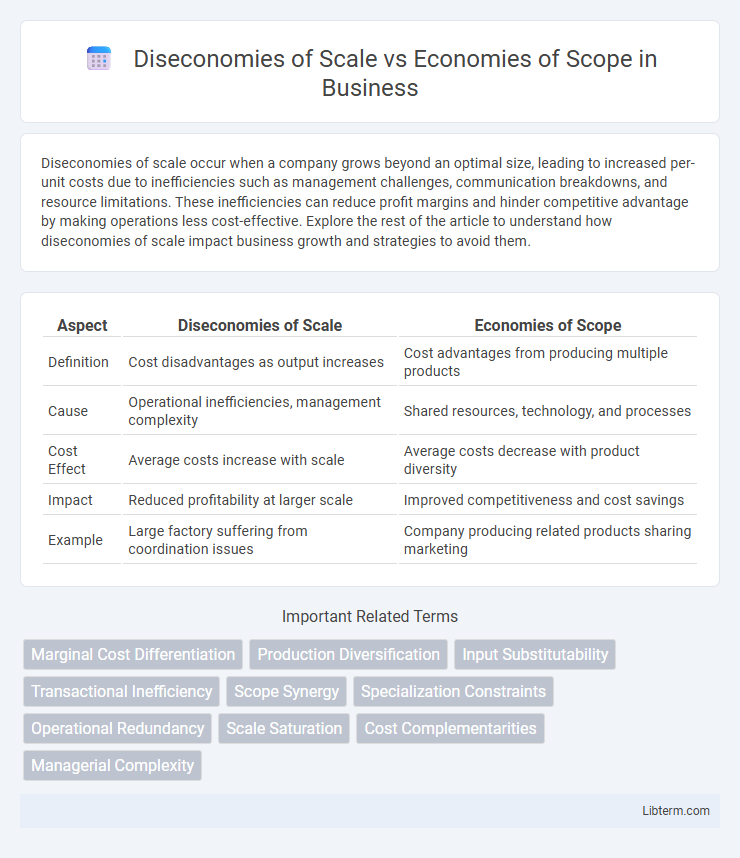Diseconomies of scale occur when a company grows beyond an optimal size, leading to increased per-unit costs due to inefficiencies such as management challenges, communication breakdowns, and resource limitations. These inefficiencies can reduce profit margins and hinder competitive advantage by making operations less cost-effective. Explore the rest of the article to understand how diseconomies of scale impact business growth and strategies to avoid them.
Table of Comparison
| Aspect | Diseconomies of Scale | Economies of Scope |
|---|---|---|
| Definition | Cost disadvantages as output increases | Cost advantages from producing multiple products |
| Cause | Operational inefficiencies, management complexity | Shared resources, technology, and processes |
| Cost Effect | Average costs increase with scale | Average costs decrease with product diversity |
| Impact | Reduced profitability at larger scale | Improved competitiveness and cost savings |
| Example | Large factory suffering from coordination issues | Company producing related products sharing marketing |
Introduction to Diseconomies of Scale and Economies of Scope
Diseconomies of scale occur when a company's per-unit costs increase as production expands, often due to management inefficiencies or resource limitations. Economies of scope refer to cost advantages gained by producing a variety of related products using shared resources or processes. Understanding these concepts helps businesses optimize production strategies, balancing between scaling operations and diversifying product lines.
Defining Diseconomies of Scale
Diseconomies of scale occur when a company's production costs increase as output expands, causing inefficiencies that reduce overall profitability. Unlike economies of scale, which lower costs through increased production, diseconomies of scale arise from factors such as management complexity, communication breakdowns, and resource limitations. These inefficiencies contrast with economies of scope, where cost advantages result from producing a variety of related products together rather than increasing volume alone.
Understanding Economies of Scope
Economies of scope occur when a company efficiently produces a variety of related products, leveraging shared resources such as technology, marketing, or distribution channels to reduce the average cost per unit. Unlike economies of scale, which focus on cost advantages from increased output of a single product, economies of scope emphasize cost savings through diversification and joint production. This strategic approach enhances competitive advantage by optimizing resource allocation and minimizing duplication across product lines.
Key Differences Between Diseconomies of Scale and Economies of Scope
Diseconomies of scale occur when a firm's per-unit costs increase as production expands, typically due to inefficiencies like management complexities and resource limitations. Economies of scope arise when producing a variety of products together reduces average costs by leveraging shared operations and resources. The key difference lies in scale affecting the volume of a single product, causing cost increases in diseconomies of scale, whereas scope focuses on cost reductions through diversified production lines.
Causes of Diseconomies of Scale
Diseconomies of scale occur when a company's production costs increase as output expands, primarily due to factors like managerial inefficiencies, communication breakdowns, and resource limitations within large organizations. Overextension of resources and increased complexity in coordination contribute to rising average costs in industries such as manufacturing or retail. Unlike economies of scope, which reduce costs by producing a variety of products using shared resources, diseconomies of scale result from inefficiencies tied specifically to scaling up a single product or service.
Drivers of Economies of Scope
Economies of scope arise primarily from shared resources, including technology, marketing channels, and distribution systems, which reduce costs across multiple products. Leveraging common inputs and cross-functional capabilities enhances product variety without proportionally increasing expenses. Firms achieve cost efficiencies by spreading fixed costs and coordinating operations across diverse product lines.
Impact on Business Operations and Performance
Diseconomies of scale occur when expanding production increases average costs due to factors like management inefficiencies and resource limitations, negatively impacting operational efficiency and profitability. Economies of scope arise from producing a variety of related products more cost-effectively together than separately, enhancing operational flexibility and driving revenue growth through diversified offerings. Understanding the balance between these concepts enables businesses to optimize scale and scope, improving overall performance and competitive advantage.
Real-World Examples in Various Industries
Manufacturing giants like Ford leverage economies of scale by mass-producing vehicles to reduce per-unit costs, while tech firms such as Apple utilize economies of scope by diversifying product lines like iPhones, iPads, and services to share resources and enhance market reach. Conversely, diseconomies of scale surface in companies like General Motors when overexpansion leads to increased bureaucracy and inefficiency, and in conglomerates like GE when managing vastly different business units causes coordination challenges and dilute focus. Retail chains such as Walmart benefit from economies of scale through bulk purchasing, but face diseconomies of scope when entering unrelated markets, impacting overall operational efficiency.
Strategies to Minimize Diseconomies and Maximize Scope Economies
Implementing decentralized management structures and enhancing communication technologies are effective strategies to minimize diseconomies of scale by reducing bureaucracy and coordination costs. Leveraging product diversification and shared resources across multiple business units maximizes economies of scope, enabling cost savings through joint production and distribution. Emphasizing flexible manufacturing processes and cross-functional teams further supports efficiency gains and innovation across diversified product lines.
Conclusion: Choosing the Right Growth Path
Choosing the right growth path involves evaluating diseconomies of scale, which occur when increasing production leads to higher per-unit costs, against economies of scope, where diversifying products reduces overall costs through shared resources. Firms experiencing diseconomies of scale benefit from focusing on efficiency and specialization, while those leveraging economies of scope gain competitive advantage by expanding product lines and exploiting synergies. Strategic decisions must balance operational complexity and cost efficiencies to optimize long-term growth and profitability.
Diseconomies of Scale Infographic

 libterm.com
libterm.com